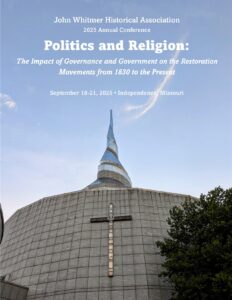A brief history of the John Whitmer Historical Association, written by William D. Russell 1
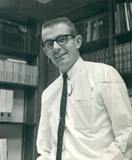
Bill Russell
On Friday night, September 27, at the 2002 Annual Meeting of the John Whitmer Historical Association in Nauvoo, a celebration of the Association’s 30th anniversary was held, at which this brief history was presented. As best I can tell, the John Whitmer Historical Association began in the summer of 1954, when University of Missouri graduate students Barbara and Bill Higdon were in Houston for the summer. Barbara was working on her dissertation on public speaking in early Mormonism.2
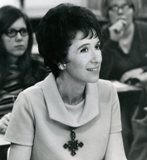
Barbara Higdon
The two of them began thinking about the need for a historical organization that would be independent of the administration of what was then the Reorganized Church of Jesus Christ of Latter Day Saints (RLDS), now Community of Christ. They drafted a proposed constitution for such an organization and sent it to the First Presidency, which at that time consisted of Israel A. Smith and his two counselors F. Henry Edwards and W. Wallace Smith. The First Presidency replied that they would take the matter under advisement.3 The Higdons did not hear any more from the Presidency on the matter.
One year later, Graceland College hired Bob Flanders and Alma Blair to teach history. They ended up sharing the freshman level Latter Day Saint History course that Roy A. Cheville had taught for years. In 1960 Paul Edwards joined the Graceland faculty to teach history and philosophy. He, too, had an interest in church history. At one point Paul applied for the Church Historian’s position and in the interview he suggested that an independent historical organization be created. Edwards recalls that President W. Wallace Smith said that would not be necessary.4 The Higdons came on board the Graceland faculty in 1963, so the numbers of faculty interested in church history was growing.
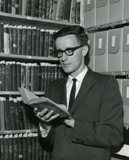
Dick Howard
Meanwhile, at church headquarters in Independence in 1965 Dick Howard replaced the retiring Charles A. Davies as Church Historian. Dick had an M.A. in history from the University of California at Berkeley and was the first professionally trained Church Historian. He also had an interest in creating an independent historical society and discussed the idea occasionally with the First Presidency.5
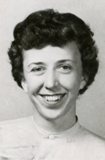
Barbara Howard
During the 1960s there was developing what was soon called “The New Mormon History”– research and publication which was more professional and attempted to be more neutral than the previous tendency to write either “faithful history” or “anti-Mormon history. “The movement can be seen as starting before 1960 in works such as Fawn Brodie, No Man Knows My History (1945), Juanita Brooks, The Mountain Meadows Massacre (1950), Thomas O’Dea, The Mormons, (1957) and Leonard Arrington, Great Basin Kingdom (1958). By the mid-1960s a flood of professional historical writing began to appear, including Bob Flanders ‘Nauvoo: Kingdom on the Mississippi (1965), Klaus Hansen, Quest for Empire (1967) and others.
This professionalization of church history and the rapid growth of the number of scholars interested in the field led to the creation, in 1965, of the Mormon History Association (MHA), led by Leonard Arrington. Soon Bob Flanders was involved in MHA and Dick Howard attended the annual meeting in San Diego in 1969 where he received MHA’s annual “best book” award for his Restoration Scriptures: A Study of Their Textual Development (Herald House). In 1971 Paul and Lyman Edwards, Dick Howard, Mark McKiernan, and Bill Russell attended the annual MHA meeting in Provo where McKiernan gave a paper on William Smith.
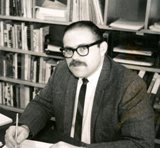
Paul Edwards
In 1970 the quarterly journal Courage: A Journal of History, Thought, and Action came into being, with Paul Edwards and Barbara Higdon on the nine-member Editorial Committee. Most of the people mentioned here so far contributed articles, reviews, letters, or editorials published in Courage, which provided an avenue for publishing historical articles and reviews. It was felt, however, that a historical society would stimulate more research and publications in the area. So on 18 September 1972, thirty years ago this month, fifteen people gathered at the home of Dick and Barbara Howard, for a meeting that can appropriately be regarded as the birthday of the John Whitmer Historical Association.
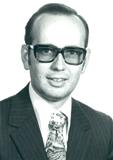
Pat Spillman
The people who attended the organization meeting were Alma Blair, Paul Edwards, Bob Flanders, Barbara Higdon, Dick and Barbara Howard, Larry Hunt, Warren Jennings, Gerald Kruse, Mark McKiernan, Grant McMurray, Gordon Mesley, Bill Russell, Geoff Spencer, and Pat Spillman.6Barbara Howard prepared a succulent repast, which might appropriately be referred to as the John Whitmer Association’s “First Supper.” The group decided not to become part of the church’s professional association roundtable, but instead “should be an independent not-for-profit corporation organized along the lines of typical societies of professional historians.”7
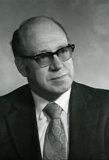
Geoffrey Spencer
My level of brilliance can be demonstrated by the fact that I moved that we call our new organization the “John C. Bennett Historical Association.” Sadly, I failed to acknowledge that I had received “light” on this matter, and my motion died for lack of a second. Then some less imaginative soul, Warren Jennings to be precise, suggested “the John Whitmer Historical Association.” The two main reasons why this motion carried the day is that John Whitmer was the first Church Historian, and secondly, that his name is not controversial and not associated with one of the two largest Mormon churches to the exclusion of the other. Maybe a third, unspoken reason was that John Whitmer resisted when the President of the Church tried to control his history.
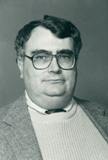
Mark McKiernan
Officers and a steering committee were chosen that night, with Bob Flanders chosen to serve as the first President of the Association and Paul Edwards the Vice President for Program, to plan the first annual meeting in Nauvoo, September 1973. Barbara Higdon was chosen as Vice President for Membership and Mark McKiernan, Secretary-Treasurer. It was considered very important that historians from among the Brighamites be included among the leadership of the Association. A Board of Directors was chosen which included Davis Bitton of the University of Utah and Stanley Kimball of Southern Illinois University. The late Richard Poll at Western Illinois University was often involved in these early meetings. Interestingly, to my knowledge Dick Poll is the only LDS person ever to have been the guest preacher at the Sunday morning worship service at the Campus Congregation at Graceland. His Dialogue article discussing “Iron Rod and Liahona Saints,” republished in the Saints’ Herald,8stimulated the invitation to speak at Graceland.
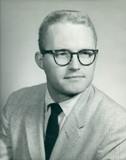
Alma Blair
The first Board of Directors included the four officers, plus Davies Bitton, Stan Kimball, Dick Howard, Alma Blair, Warren A. Jennings, William Russell, and Gordon Mesley. A steering committee was appointed which consisted of the four officers plus Dick Howard. The steering committee met in Springfield, Missouri at Flanders’ home on November 24-25, 1972, and laid out a preliminary set of procedures and goals.9
The following six objectives were agreed upon:
- To create a professional association that is predominantly Midwestern in focus, taking advantage of the associational and friendship networks of persons of RLDS background.
- To collect and preserve publications, documents, manuscripts, and other valuable materials relating especially to the history of the Reorganization.
- To facilitate communication among the various persons and agencies that serve the generic Mormon historical community: the LDS Church Historian’s office, the RLDS Church Historian’s office, the Mormon History Association, various public and private libraries that have and collect Mormon materials, especially in the Midwest, and the persons who write Mormon history, especially the history of the RLDS, the churches of the dispersion, and the early Midwest period of Mormon history.
- To draw into the fellowship of the association persons who may share many of its concerns, but not be themselves members of the Reorganized Church– especially such persons who live in the Midwest.
- To infuse the spirit of renewal in the Reorganized Church of Jesus Christ of Latter Day Saints and in the larger fellowship of Christians, into the work of the historians of Mormonism and the perspective which they carry to their work.
- To enhance and facilitate the marvelous and fruitful association which has developed in the past few years with many friends in the Church of Jesus Christ of Latter-day Saints.10
Committees were formed for creating articles of association, and other duties needed to get the historical society under way.
Among the Past Presidents of the Association are LDS members Linda Newell and Jessie Embry. The only LDS historian to serve as Editor of the journal is Jessie L. Embry, but a number have served on the Editorial Committee. In order of service, they are Michael Quinn, Lorie Stromberg, Valeen Avery, Ron Esplin, Carol Cornwall Madsen, Gregory Prince, Jessie Embry, Martha Sonntag Bradley, and Newell Bringhurst. During the first seven years of the journal’s existence (1981-1987) Grant McMurray and Peter Judd served on the Editorial Committee, with Peter serving as Editor for volumes 6 and 7. Grant and Peter no doubt gained valuable experience to prepare them for their current roles as members of the First Presidency of the Community of Christ.
There have been many LDS historians who have given papers a tour Annual Meetings. We have also had active participants from among the Strangites and persons outside the Mormon fold. Among the non-Mormons who have presented major papers at our meetings have been Jan Shipps, Larry Foster, Mario DePillis, Paul Jones, Kenneth Winn, and Susan Curtis.
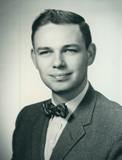
Robert Flanders
President Flanders presided over the first annual meeting held in Nauvoo in September 1973. The last full weekend in September has been the regular meeting time throughout our history. If October 1 falls on a Saturday or Sunday, the meeting is held the previous weekend.
At that first annual meeting in Nauvoo in 1973 Bob Flanders delivered our first Presidential Address. Jan Shipps presented her “Prophet Puzzle” paper on Joseph Smith, which has often been cited by other scholars. The demise of Courage in 1973 after a short life of eleven issues in three years took away a major opportunity to publish in the field of RLDS history, although the beginning of the Mormon History Association’s annual Journal of Mormon History the next year gave some opportunity for Whitmer papers to be published. Jan Shipps, “The Prophet Puzzle,” was the lead article in the first issue in 1974.
11 Other Whitmer lectures which were published in those early issues of the Journal of Mormon History were written by Larry Hunt (1977),12 Nancy Hiles Ishikawa (1979),13 Dick Howard (1980),14 Newell Bringhurst (1981),15 and Paul Shupe (1983).16
Three prominent John Whitmer founders – Mark McKiernan, Alma Blair, and Paul Edwards — fostered cooperation between RLDS and LDS historians by their publication of The Restoration Movement, a collection of thirteen essays, six authored by RLDS historians and the other seven by some of the finest LDS historians — James Allen, Leonard Arrington, Davis Bitton, Klaus Hansen, T. Edgar Lyon, Max Parkin, Larry Porter and D. Michael Quinn.17
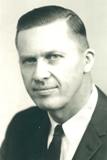
Gerald Kruse
In the spring of 1974 John Whitmer, in cooperation with the Graceland history faculty, began an annual spring “Restoration History Lecture Series,” which lasted until 1990. Many of the prominent LDS historians gave lectures in this series, including Leonard Arrington, Jim Allen, Dick Poll, Maureen Beecher, Melvin Smith, Chas Peterson, Doug Alder, Stan Kimball, David Buerger, Linda Newell, and Carol Cornwall Madsen. One of the first lecturers was Arrington, who, when he came on stage, saw Dick Howard in the audience. Leonard jumped off the stage (a three foot drop) and enthusiastically greeted Howard. His contagious personality no doubt changed the attitudes of those students who might have been leery of this Mormon in our midst. Soon the spring series included lectures in Independence as well as Lamoni. Two outstanding Graceland students presented their history senior seminar papers in the spring series — Susan Curtis (1977) and Paul Shupe (1981). Their papers were published later in the John Whitmer Historical Association Journal and the Journal of Mormon History.18
Since 1978 John Whitmer has sponsored a banquet in Independence the night before World Conference officially begins.19 Dick Howard’s assistant, Grant McMurray, was beginning to show promise and was asked to speak at the first banquet in 1978.20Ironically, McMurray chose to speak on the issue of succession in the Presidency of the church. At that 1978 World Conference Wallace B. Smith would be succeeding his father as President, the first time an RLDS President had retired rather than serving until his death. Eighteen years later McMurray would himself succeed Wallace B. Smith as President of the Church, becoming the first non-Smith to lead the church. In 1980 the pre-conference banquet speaker was F. Henry Edwards, who had been a member of the RLDS First Presidency from 1946 until 1966 and the author of volumes 5-8 of the official history of the church.21 Other speakers have included Ruth Draper, Saint Paul School of Theology professor Paul Jones, and LDS scholars Valeen Avery, Michael Quinn, Allen Roberts, Phillip Barlow, and both Paul and Lavina Anderson.
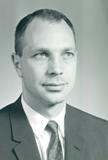
Gordon Mesley
At our September 1986 annual meeting we were given a tour of the Kirtland Temple by Jeffrey Don Lundgren, who in a little more than three years would become, at least for the moment, the most well-known of all participants in John Whitmer programs.22 By 1981 there had been so many good papers delivered at Whitmer meetings that it was deemed important to publish an annual journal. Over the years significant financial assistance came from George Smith and from Tom Morain. Tom arranged a three-way partnership between Living History Farms in Des Moines, Graceland College, and the John Whitmer Association, which benefited John Whitmer financially. These two men helped secure a firm financial base for the journal.
Today our endowment fund is over $100,000 and has been used for other purposes in addition to the journal. In recent years, for example, we have created scholarships to help young historians become involved by attending meetings and presenting papers. John Whitmer also has begun a monograph series, with two monographs published: Marjorie Newton, Hero or Traitor: A Biography of Charles Wesley Wandell (1992) and Gregory A. Prince, Having Authority: The Origins and Development of Priesthood During the Ministry of Joseph Smith (Independence Press, 1993).23 Each year we give awards for the annual “best book” and the “best article, “and other special awards from time to time. I was privileged to be honored with” The True Believer Comeback of the Year” award in 1985, presented by Awards Chairman Grant McMurray and President Dick Howard. To date, no other member of the Association has received this coveted award.
The Association determined at the outset to be independent of the church. During the first twelve years Dick Howard declined several invitations to be President of the Association, feeling that the image of independence from the church would be stronger if the Church Historian were not the John Whitmer President during the early years. Dick’s 1983 article in the journal was an example of cooperation between the church and the Association, in this case on the sensitive issue of polygamy, Non-Mormon historian Larry Foster had given a paper on polygamy at the 1977 Mormon History Association meeting at Kirtland, as part of the preliminary work on his important book, Religion and Sexuality.24 Bill Higdon, ordained an apostle in 1974, attended Foster’s session. Upon his return to Independence, Higdon urged President W. Wallace Smith to call a meeting to discuss this matter, as Higdon felt that if news of Foster’s research and conclusions spread among church members, they might be very troubled, and church leaders needed to be prepared to deal with it. Soon a meeting was called which was attended by President Smith, his son Wallace B. Smith, who at that time was slated to become President of the Church one year later, in April 1978, as well Clifford Cole, President of the Council of Twelve, Presiding Bishop Francis E. (Pat)Hansen, and Church Historian Dick Howard. As a result of that meeting Howard was asked to research the subject and produce a document that could be used to educate the members of the church.
In early November 1982 Howard submitted a paper to President Wallace B. Smith, who decided to share copies of it with all members of the Joint Council (which consisted of the 18 men who made up the First Presidency, the Presiding Bishopric, and the Council of Twelve) and with the members of the History Commission, an advisory group established by the Church Historian and the First Presidency. Copies were sent on the same day to these people. The History Commission reviewed it on December 5, 1982, at a meeting held at Graceland College in Lamoni, Iowa. The Joint Council discussed it the next day in Independence. “The consensus of the Commission meeting at Lamoni was that the paper was too mild. The Joint Council generally felt the paper was too radical,” recalls Dick Howard.25 In January 1983 Howard had several sessions with the First Presidency regarding his paper, with Paul Edwards, very recently the new President of the Temple School, also in attendance. By the end of January, the paper had received the editorial input of several church officials, and the final revision was what Dick Howard recalls as a “painful compromise.”26 He recalls that some of his nine conclusions were tempered and a section on “commonsense” was deleted.27
President Smith thought the paper Dick produced should be published but didn’t want to publish it in the Saints’ Herald, the official RLDS publication. The John Whitmer Historical Association was asked if they would publish it. Clare Vlahos was the Editor that year and agreed. Dick’s paper was published in volume 3 (1983), with the volume being released on the same day, September 24, 1983, that Dick presented the paper to our annual meeting, held that year at the Walnut Gardens RLDS Congregation in Independence.28 Dick Howard’s 1983 publication is an important incident in the history of our church. With this article the official Church Historian, after consultation with the First Presidency and other top church officials, acknowledged the fact that we cannot excuse Joseph Smith, Jr. from involvement in polygamy. We can’t blame it on Brigham anymore, after more than a century of accusations. Therefore, it seems that when we publish the second edition of Paul Edwards’ official history of the church,29 Dick Howard’s 1983 John Whitmer publication should be discussed in the text and cited in the chronology of important events, even though it would have been a better paper if it hadn’t been subjected to political considerations in the editorial process. And the footnote should be to the 1983 John Whitmer Historical Association Journal rather than to its later republication in Restoration Studies III in 1986.30
Shortly after Dick Howard’s article appeared in our journal, Richard Price published a full page ad in the Independence Examiner “correcting” the errors in Howard’s article. In response to Price, the First Presidency distanced itself from Howard’s article by issuing a press release noting that the John Whitmer Historical Association Journal was not an official publication of the church and its authors do not reflect official church positions.31 Dick might be said to have felt he was “left hanging, slowly twisting in the wind,” to borrow a phrase from the Watergate episode.
Our Association has been known to sometimes fall short of the expectations contained in our bylaws. For example, Tom Morain was reappointed Membership Committee chairperson in 1987 and 1988 despite protesting that he had done absolutely nothing in that role in 1986 and 1987.32 Once at an annual business meeting the Executive Secretary of the Association was unable to take any minutes because he spent the whole time trying the find the minutes of the previous business meeting held one year earlier.
Any organization is bound to have some internal conflicts, as members have differing ideals and objectives for the group. Possibly the main internal conflicts have been over whether the Association has been sufficiently independent of the church. Writings that were critical of high church officials and prestigious Whitmer members have not always been appreciated. Also an article by David Buerger on Mormon infallibility was rejected by our Editor out of a concern not to offend the LDS Church.
There has sometimes been a tendency to ask the same old John Whitmer insiders to give papers at meetings, and some think we tend to meet in or close to Independence too often, rather than taking the effort to include new people and go to new places for our meetings. So far, we have not ventured outside the Midwest for an annual meeting. A majority of our annual meetings have been held in the Independence area, at Graceland College or in Nauvoo. We have met twice each at Kirtland, Plano, and St. Louis. Other meetings have taken place at Council Bluffs, Shenandoah, and Des Moines, Iowa. The average attendance at our annual meetings has been around 100, out of a membership that has remained fairly stable at around 400.
1 Conversations with and emails from Richard P. Howard, Barbara Higdon, Paul M. Edwards, William T. Higdon, Wallace B. Smith and Barbara Bernauer, were very helpful in reconstructing the early history of the Association. The author wishes to thank these people for their invaluable assistance.
2 Barbara McFarlane Higdon, Preaching in the Latter Day Saint Church,1830-1846 (University of Missouri dissertation, 1941).
3 Barbara Higdon, email to Bill Russell, July 9, 2002.
4 Paul Edwards, email to Bill Russell, August 16, 2002.
5 Richard P. Howard to William D. Russell, May 8, 1981, p. 2.
6 “Historical Society Formed,” Saints’ Herald 119 (December 1972):58-59; Howard to Russell, May 8, 1981.
7 “The Origin of the John Whitmer Historical Association,” The John Whitmer Historical Association Journal 1 (1981):63. This brief, informal, unsigned history of the Association was written by this author upon the request of Imogene Goodyear, the first editor of the journal.
8 Richard D. Poll, “What the Church Means to People Like Me,” Dialogue: A History of Mormon Thought 2:4 (Winter 1967):107-117; reprinted in the Saints’ Herald 115 (October 15, 1968):699-700, 705-06, and in Dialogue 34:1&2 (Spring/Summer 2001): 11-21.
9 “The Origin of the John Whitmer Historical Association,” John Whitmer Historical Association Journal 1 (1981):63. Gordon Mesley’s last name was misspelled in this article.
10 Ibid.
11 Jan Shipps, “The Prophet Puzzle: Suggestions Leading Toward a More Comprehensive Interpretation of Joseph Smith, “Journal of Mormon History 1 (1974):3-20.
12 Larry E. Hunt, “Frederick Madison Smith: The Formative Years of an RLDS President,” Journal of Mormon History, 4(1977):67-89.
13 Nancy Hiles Ishikawa, “Alice Smith Edwards: The Little Princess,” Journal of Mormon History, 6(1979):61-74.
14 Richard P. Howard, “Joseph Smith’s First Vision: The RLDS Tradition,” Journal of Mormon History, 7 (1980):23-29.
15 Newell G. Bringhurst, “Charles B. Thompson and the Issues of Slavery and Race,” Journal of Mormon History 8 (1981):37-47.
16 Paul Shupe, “Indulging in Temperance: Prohibition and Political Action in the RLDS Church, “Journal of Mormon History 10 (1983):21-33.
17 McKiernan, F. Mark, Alma R. Blair, and Paul M. Edwards, eds., The Restoration Movement: Essays in Mormon History (Lawrence, Kansas: Coronado Press, 1973) One essay had two authors. The RLDS historians who contributed articles in this collection were, in addition to McKiernan, Blair, and Edwards: Robert Flanders, Warren Jennings, and William Russell.
18 Susan Curtis Mernitz, “Palmyra Revisited: a Look at Early Nineteenth Century America and the Book of Mormon,” John Whitmer Historical Association Journal 2(1982):30-37; Paul Shupe, “Indulging in Temperance and Political Action in the RLDS Church, “Journal of Mormon History 10 (1983):21-33.
19 “The Origin of the John Whitmer Historical Association,” 64.
20 W. Grant McMurray, “‘True Son of a True Father: ‘Joseph Smith III and the Succession Question,” Restoration Studies I(1980):131-145.
21 F. Henry Edwards, “Engagement with Church History,” John Whitmer Historian Association Journal 1 (1981):30-33.
22 In April 1989, Lundgren, a former Kirtland Temple tour guide, murdered a family of five who were followers of his. He is now on Ohio’s Death Row in Mansfield. Two books have been written on the subject: Pete Earley, Prophet of Death: The Mormon Blood-Atonement Killings (New York: William Morrow and Company, Inc., 1991) is reasonably-well done. Cynthia Stalter Sasse and Peggy Murphy Widder, The Kirtland Massacre: The True and Terrible Story of the Mormon Cult Murders (New York: Donald I. Fine, Inc., 1991) could have been written without looking beyond the newspapers and the papers in the prosecutor’s office.
23 Marjorie Newton, Hero or Traitor? A Biography of Charles Wesley Wandell (Independence: Independence Press, 1992); Gregory A. Prince, Having Authority: The Origins and Development of Priesthood During the Ministry of Joseph Smith (Independence: Independence Press, 1993).
24 Lawrence Foster, Religion and Sexuality: Three American Communal Experiments in the Nineteenth Century (New York: Oxford University Press, 1981).
25 Richard Howard, email to Bill Russell, August 24, 2002.
26 Richard Howard, email to Bill Russell, August 24, 2002.
27 At the September 27, 2002, thirtieth anniversary celebration, Richard Howard offered this information in response to a question regarding ways in which his paper had been watered down by church officials prior to publication.
28 Richard P. Howard, “The Changing RLDS Responses to Mormon Polygamy: A Preliminary Analysis,” John Whitmer Historical Association Journal 3 (1981):14-29..
29 Paul M. Edwards, Our Legacy of Faith: A Brief History of the Reorganized Church of Jesus Christ of Latter Day Saints (Independence: Herald Publishing House, 1991).
30 Richard P. Howard, “The Changing RLDS Response to Mormon Polygamy: A Preliminary Analysis,” Restoration Studies III (1986):145-162. In the bibliography of his Legacy of Faith Edwards cites this 1986 reprint rather than Howard’s original 1983 publication of the article.
31 Wallace B. Smith, email to Bill Russell, September 2, 2002.
32 Tom Morain to Les Gardner, February 28, 1988.
